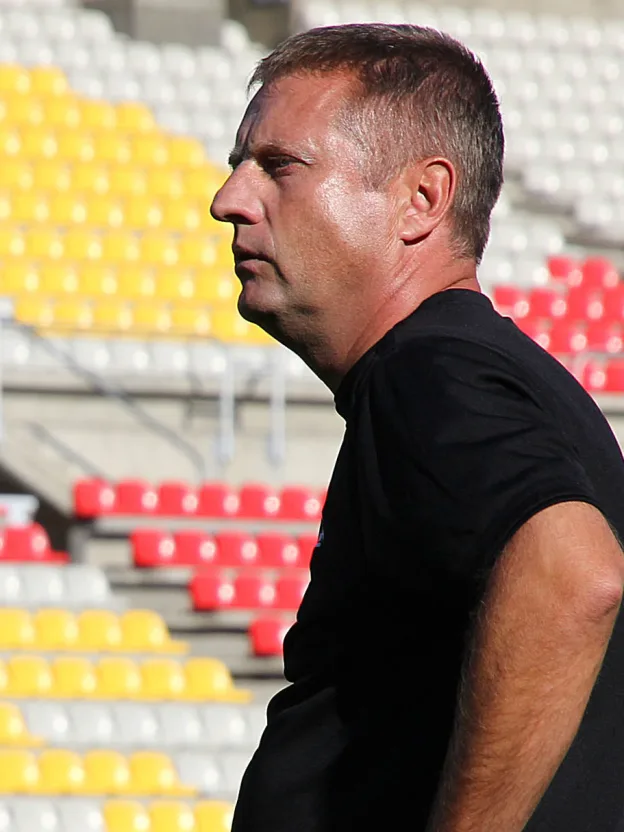**“For the development of this league, I cannot think of anybody that’s been more influential. All these kids, they had to go through him.” **— Hanson Boakai
Quick, name a Canadian CPL player. Anyone. Now check their Canada Soccer profile. There’s a 30 to 40 per cent chance the name Sean Fleming shows up somewhere on his player timeline. In his 15 years as a youth coach for the Canadian Soccer Association (seven as head coach of Canada’s under-17s), Fleming — an assistant coach with FC Edmonton until the end of 2020 — has seen the cream of every crop of young players pass before him. Don’t believe it? Take a deep breath, here are some of the current and former CPLers to pass through a Fleming camp. Marcel de Jong, Roger Thompson, Sergio Camargo, Luca Gasparotto, Keven Alemán, Michael Petrasso, Chris Nanco, Hanson Boakai, Marco Bustos, Terran Campbell, Kadin Chung, Marco Carducci, James Pantemis, David Norman Jr., Marcel Zajac, Kunle Dada-Luke, Tristan Borges… That’s almost every CPL club represented. How about the men’s national team? Samuel Piette, Atiba Hutchinson, Alphonso Davies, Jonathan David, Maxime Crépeau, Russell Teibert, Adam Straith, Ballou Tabla… And so on.
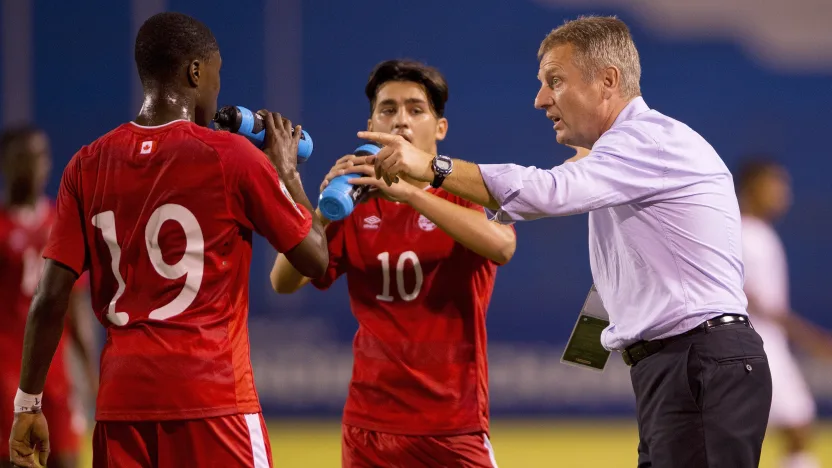
Back in November 2019, Cavalry FC coach Tommy Wheeldon Jr. — fresh off of accepting his CPL Coach of the Year award — wandered into the Canadian Premier League headquarters, and got to chatting with the CPL Editorial crew. Storytime, somehow, turned toward Fleming — with whom Wheeldon had coached in 2015, with Canada’s under-17s and under-15s. “I got my wheels spinning,” Wheeldon recalled later for CanPL.ca. “Because after leaving the CPL Awards, you see Marco Carducci get the Golden Glove, and you see (Tristan) Borges win the Golden Boot and the MVP, I picked up the coach’s one. You taper it back, and we’re all part of the tree that Sean Fleming sprouted. “Sean probably doesn’t get the accolades — nor does he chase them, in fairness — that he’s deserved.” Sometimes, you hear a story, and you’re stunned you haven’t heard it before. This was one of those times. Fleming’s resume is immense, having worked with Canada Soccer in various capacities from 1996 to 2016. He led Canadian teams to two FIFA U-17 World Cups, and he was part of the staff when they hosted the 2007 U-20 World Cup. Of the 47 players called up to the senior national team in 2019 and 2020, 21 played for Fleming at some point. He took the reins of the under-17 program from now-HFX Wanderers boss Stephen Hart in 2008, and he handed them off to York United’s Paul Stalteri in 2016. Rob Gale of Valour FC was Fleming’s assistant for years before moving into the under-18 and under-20 roles. Wheeldon, of course, accompanied him in his final Canada Soccer campaigns, at the tail end of the Canadian coaching lineage to pass through the youth programs. And for two years in the CPL, Fleming was a confidant to Jeff Paulus back in his hometown of Edmonton. With Paulus leaving the Eddies in late 2020, Fleming too made way for a new generation of coaches under Alan Koch, with the incoming manager opting to assemble a new staff. The past 20 years were a turbulent era for Canadian soccer. The men’s national team has gone through 10 managers since 2000 while struggling to translate talent to success on the pitch. Turnover that frequent serves only to make longevity all the more impressive, which is why Fleming’s influence on the sport today can’t be understated. His fingerprints are all over the game in this country. “He’s a common denominator in a lot of this,” said Wheeldon. So proceeded a deluge of anecdotes about a man as well-travelled in world football as any. From Alphonso Davies, to Arturo Vidal, to a five-time Stanley Cup champion (and everywhere in between), here are several decades’ worth of stories of a true titan of Canadian soccer.
“A Canadian football royalty about them”
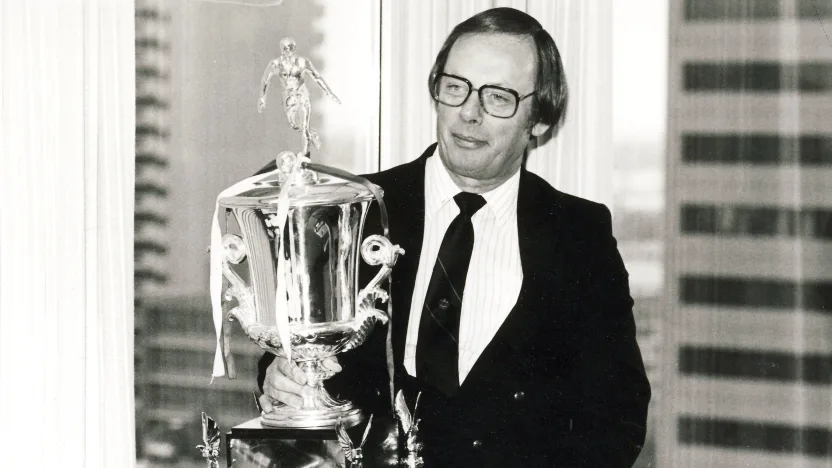
To start, we need to go back to the 1980s, and the University of Alberta. Fleming was in school, playing soccer and training to become a teacher. His father, Jim, was president of the Canadian Soccer Association, having risen to the top of the football community here after moving his family from Scotland in 1968. Today, Jim Fleming is in both the Canada Soccer and the Concacaf Halls of Fame, and he received FIFA’s Order of Merit in 2002 (Canada’s only recipient of the honour to date). “There’s almost a Canadian football royalty about them,” Wheeldon said of the Flemings. The sport itself was enjoying something of a surge in Canada at the time, with the men’s national team playing at the 1984 Olympics and the 1986 World Cup. Sean Fleming, meanwhile, was mulling his options. “I really didn’t know what I wanted to do,” he told CanPL.ca. “I just thought, ‘How can I coach, and get paid?’ So I thought I’d become a teacher.” From there, his involvement with the sport in Alberta exploded. Fleming says it was Bert Goldberger, the first full-time technical director hired by a Canadian provincial soccer association, who gave him an early start. “He gave me a chance to start going to coaching courses, and I’d just go and basically pick up cones, and get the balls for instructors,” Fleming remembered. It was from that start that Fleming honed his coaching style — the no-nonsense, no-excuses demeanour that’s won over players and fellow coaches for years. Fleming’s trajectory shot upwards from there, as he crossed paths with legends of Canadian soccer coaching like Tony Waiters (gaffer for the ’86 World Cup squad), Ross Ongaro, and, eventually, Holger Osieck (national team coach from 1998-2003) — who asked him to run the CSA’s National Training Centre in the prairies. Then, Stephen Hart came calling with the national under-17 program. “(Fleming) had extensive experience at the provincial level, and he also had professional experience with the (NPSL indoor league) Edmonton Drillers,” Stephen Hart explained to CanPL.ca. “One of the things I try to do with an assistant is to have someone that’s not just going to agree with everything that I say, that’s willing to put in their input and even challenge some of the things you say. Sean was definitely someone that fit in that category.” The ball was in motion for Fleming.
“We’ll go out there and we’ll die for each other”
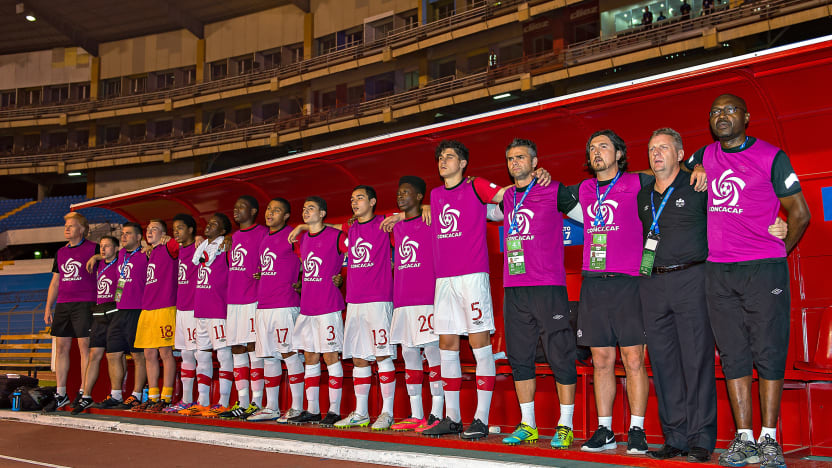
Tommy Wheeldon Jr.’s first experience coaching a team with Sean Fleming was in 2014. Fleming tapped Wheeldon, who’d just earned his UEFA A Coaching License, to join him and the under-17s at the Tournoi Montaigu in France that spring. It was there that the now-Cavalry boss saw why Fleming had taken two consecutive generations of players to the World Cup. “He’s very demanding of high standards,” Wheeldon recalled. “In the morning, we always had breakfast at a certain time, and before breakfast, we always sang the national anthem. “He always centered it back to, you’re representing your country. You might be 16 years of age, but this is what it’s about.” Fleming also curated a wall of fame at his teams’ base camps, adorned with previous national team titans — Domenic Mobilio, Craig Forrest, Jason De Vos, and so on — to keep things in perspective. Wheeldon was an assistant coach for Fleming throughout the 2015 U-17 World Cup cycle, helping shape a cast of players including Tristan Borges, Terran Campbell, Kadin Chung, and Ballou Tabla. The Canadians missed out on World Cup qualification by a hair, the format having changed to a massive six-team group stage for 2015. They finished a point behind group winners Mexico to miss out on automatic qualification, and a 3-0 playoff loss to Costa Rica — in San Pedro Sula (where else?) — put a dagger in their quest. Still: Wheeldon credits that 11-month campaign for opening his eyes to one of Canadian soccer’s most legendary figures. Indeed, he may not be the coach he is today were it not for that time under Fleming’s wing. Wheeldon has in the past been known to joke that, in discussions with his own assistant coaches, he’s ‘Mister 51 Per Cent’ — that is, he’ll take all suggestions, but the final call is his. “I got that from Sean,” Wheeldon said, recalling a fellow assistant coach, Patrick Tobo, using that line on the gaffer — who took it in stride and adopted the saying into his arsenal of quips. That 49 per cent is a key part of how Fleming operates, though. Perhaps what’s made him most successful is his willingness to ask questions, and to look well beyond the confines of the soccer community for solutions to problems. “What Sean did was he’s very good at building teams,” Wheeldon explained. “Sean was able to surround himself with the best people possible.” The best example of that, by far, comes from Wheeldon’s first trip with the under-17s to France. “We were playing in the Montaigu Tournament, and I got to know the (team) doctor,” Wheeldon reminisced. “He had this book open on baseball, was talking about baseball injuries. I noticed he had baseball cleats on. “It went on two or three days, and the doctor would always come to me and ask about this or that, and I would ask him about baseball, just trying to create a middle ground. (One day), Sean turned around and laughed, he said, ‘So you like our doctor, hey?’ “I said, yeah, he’s a great guy. Really insightful. Loves his baseball, doesn’t he? “Sean said, ‘Yeah, not as much as he loves his hockey.’ “‘Really?’ “‘Yeah, he’s won five Stanley Cups with the Edmonton Oilers.'” The doctor in question was Randy Gregg (pictured above, far left), a defenceman for the Oilers in the ‘80s and, now, an Alberta sports physician, who accompanied Fleming to almost two dozen Canada Soccer competitions between 2009 and 2015. Fleming was no stranger at all to reaching across the divide to other sports, especially when it came to figuring out how best to get his players to buy into his messaging. Early in his tenure as under-17 coach, he now remembers thinking back to his stint as an assistant with Dale Mitchell’s under-20s. “One of his players said to me, ‘Sean, we’ll just go out there and we’ll die for each other,'” Fleming said. “(Mitchell) created that, because we don’t have it that much in the national program… So how do you get that in a short period of time?” “I’d go call up Hockey Canada,” he revealed. “There was the World Juniors you’d watch, and hear about the guys coming from rival leagues, rival teams, and you’d get them together as a group and that Canadian spirit was there. They were excellent in giving me some ideas.”
“He took me from literally nowhere”
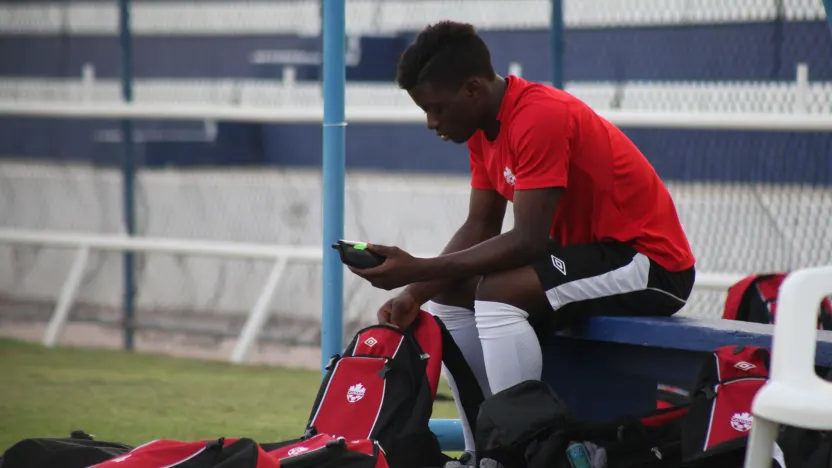
Former FC Edmonton winger Hanson Boakai is just one of many players to pass through Fleming’s sights over the years. “Sean has always been like a father figure to me,” Hanson Boakai told CanPL.ca, recalling how he — having moved to Canada from Guinea as a seven-year-old in 2007 — was first spotted by Fleming while playing locally in Edmonton. “He took me literally from nowhere and he believed in me in the beginning,” Boakai remembered. “So for me, he’s like a father who believes in a son.” Boakai has vivid memories of his first encounter with the legendary coach. The 23-year-old, at the time a teenager playing for Xtreme FC in the Albertan capital, remembers the buzz that seemed to hang around games when word got out that Fleming would be visiting. “He’d been coming here and there, just showing up in the stands,” Boakai recalled. “And when Sean Fleming’s coming to our game, everybody’s excited, because he’s the real deal.” Before Boakai knew it, the phone was ringing. He’d been invited to a Canada Soccer under-15 identification camp. “I was in school, I get a call, and (Fleming) introduces himself,” he said. “For me as a kid, it was one of the best days of my life. Every kid dreams of playing for the national team, right? And this guy… believes in me, of all the kids. I’m just some kid, you know? Boakai would go on to play a vital role for Fleming’s under-17 during the 2013 World Cup cycle, scoring twice at the Concacaf championship and playing every minute of the group stage in Dubai. “Me and Sean have a lot of memories, actually. We travelled together if we were going to a camp, we have so many little moments. “He really took care of me.” To this day, Boakai is grateful to Fleming for jump-starting his career. He’d go on to star for the NASL Eddies, before making the jump to Europe for stints all over Scandinavia and the Balkans. He revealed that Fleming’s assistant coaching post at FC Edmonton was a major factor in his decision to return to the club for 2020. “Oh, a hundred per cent,” Boakai cut in when asked. “There are many reasons I chose Edmonton, but that’s definitely one of the reasons. Like, no doubt. Hundred per cent.” It may not quite have worked out for Boakai in his Eddies return in 2020, but nonetheless he was happy to return, even if briefly. That said, it might’ve taken Boakai a little time to realize how impactful Fleming’s coaching really was to him. “At the moment, it may not have seemed like I was grateful, because I just wanted to have fun, enjoy the moment,” Boakai admitted. “He made me so much more mature.” “If (players) were to talk on Sean’s influence at first, they’d probably be like, ‘Oh jeez, he was tough on us,'” Tommy Wheeldon Jr. said. “But I think he was the right coach at the right time for these players, because they’re on the cusp of professional football.” The coach continued: “I think (Fleming) would often preach simple things, and sometimes the 16-year-olds would be like, ‘Oh, yeah, yeah.’ Now, the ones that have made it probably reflect back, and go, you know what — and Hanson Boakai is a great example of that — he was telling me all the things I needed to hear but didn’t want to receive them at the time.” Ultimately, though, we might not know Hanson Boakai’s name (nor those of many others) were it not for Fleming. Just as he did with dozens of teenage players, Fleming picked Boakai out of local football and put him on the national radar.
“Nah, this is the first time we’ve met”
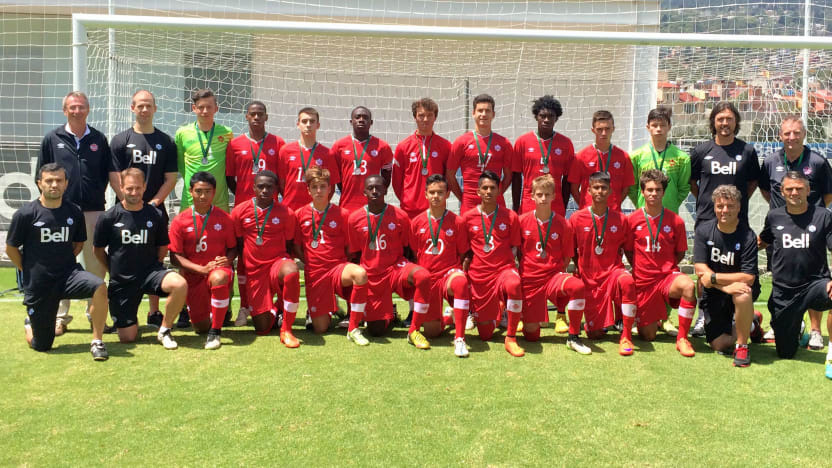
Fleming had a hand in discovering many of the players to star for CPL sides or the national team in recent memory — particularly those who didn’t come from MLS academies. There’s one such story that sticks out, though. His final national team camp was an under-15 friendly tournament in 2015, for which Fleming (along with Wheeldon) picked a squad to travel to Mexico. He brought along one notable winger who’d caught the attention of the Vancouver Whitecaps academy, as well as a relatively unknown attacker from Ottawa Gloucester SC. “That’s where Alphonso Davies and Jonathan David were,” Fleming said. “That’s the first time I saw them together.” Wheeldon recalls a modicum of surprise at seeing David brought into the camp. “Sean’s always done what’s right,” Wheeldon affirmed. “He felt, what he saw in this kid from a provincial program, irrespective of whether he was in an academy, he just thought that kid was made for this camp… He thought this kid was right for Canada.” David had featured at a couple of identification camps, but he hadn’t yet been part of a national team squad. The rest, as they say, is (recent) history. “I’d never seen two players have such chemistry,” Fleming waxed. “I would just put them together… the way they had the Mexicans just wooing about them. The way they could combine and work together, it was great.” “Oh my word, yeah,” Wheeldon agreed. “This was two 14-year-olds that are taking on Mexico, who are way street-smarter, usually, than our Canadian group. . . I remember having the conversation with both Jonathan and Alphonso, I said, have you guys played together? “And they went, ‘Nah, this is the first time we’ve met.'” Wheeldon recalled that Canada emerged with silver medals from that four-team friendly tournament, drawing with Mexico and beating two other teams to finish a close second to the hosts on goal differential. Fleming’s parting gift to the Canadian national team, then, was helping fast-track Canada’s latest generation of young stars. He was there at the dawn of the Alphonso Davies and Jonathan David era.
“Okay, any weaknesses?” “No, not really.”

The man himself is hesitant to use the phrase “golden generation” for the current cast of Canadian talent, though. Fleming has seen many a cohort of young Canadians in his time. Some of those groups have had special players — his 2011 World Cup squad gave us Samuel Piette, Maxime Crépeau, and Michael Petrasso, among others. In fact, that squad produced one of the best results in Canadian youth national team history, when a last-minute equalizer from Quillan Roberts (yes, the goalkeeper) secured a World Cup draw against an England side featuring Raheem Sterling and Jordan Pickford. It should be noted that Roberts’ goal is still, to date, the only time a ‘keeper has scored at a FIFA World Cup, at any level. Fleming’s 2013 World Cup team gave us Marco Carducci, Derek Cornelius, Jordan Hamilton, and Boakai. But still, by his own measuring stick, Fleming won’t apply the “golden generation” label to any group of Canadians — yet. “For us to qualify for the (2011 U-17) World Cup, it was a big deal because it had not been done for many years,” Fleming said. “But I’m hesitant to say a golden generation. Chile had a golden generation,” he asserted. “With (Arturo) Vidal, and (Alexis) Sánchez, that’s who I saw.” Canada, with Fleming as an assistant, played that generation of Chileans in the opening match of the 2007 U-20 World Cup at BMO Field. “What a team,” Fleming recalled. “What a team. I remember at halftime, Dale (Mitchell) and Nick (Dasovic) and I sitting there, and Dale goes, ‘Okay you guys, any weaknesses? Anything?’ “And I felt terrible because Nick and I just look at each other and go, ‘No, not really.'” Canada fell 3-0 to Chile in that game to open their winless group stage, sadly. Still, the experience was a formative one for Fleming, who now sees Vidal and Sánchez suiting up regularly for Inter Milan. Today, of course, Davies is a star for Bayern Munich, and David has become an established goalscorer in France’s first division with OSC Lille. Perhaps we’ll have to ask Fleming again in ten years about that “golden generation” tag.
The Next Chapter
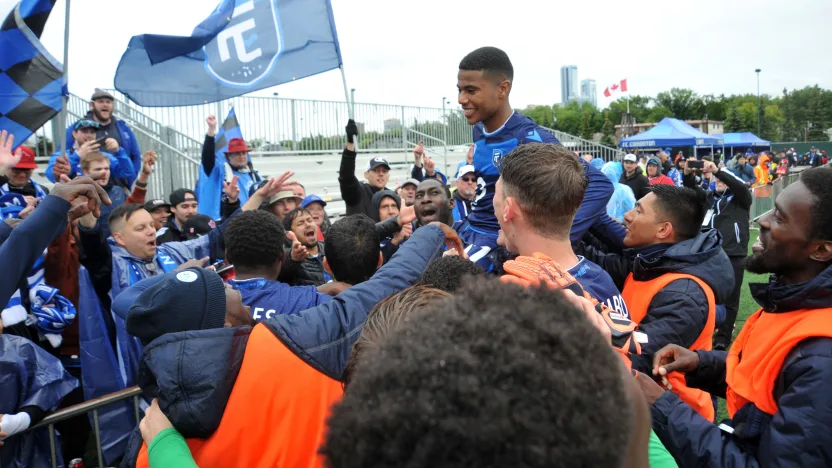
Over the years, Sean Fleming has watched legions of his former players grow up and move on to successful pro careers. “It’s quite gratifying, to be honest,” he said. “To see how many players have gone on to professional careers in Europe, and in the CPL every team has players I had the privilege of working with. “It’s very humbling in some ways.” Since Fleming has seen such growth in the last 20 years of Canadian soccer, who better to ask where it’s headed in the next 20? It’s hardly a revelatory statement to say that, generally, soccer in Canada today is miles ahead of where it was 20 years ago (although, for those keeping score, that’s one Concacaf Gold Cup for the 2000 era to zero for the modern crop). According to Fleming, the youth game has advanced enough to make recruitment for age-level national teams a little less complicated. He tells a story of, around 2012 when Thomas Rongen was academy director at Toronto FC, he and trusted assistant coach Patrick Tobo toured the club’s newly-opened training facility. “I remember stopping, and saying, ‘You know Patrick, five years ago would you ever predict there would be a training facility for football in Canada like this?’ And now there’s several of them,” Fleming said. “In my early days at the under-17s, at the beginning of a cycle, a low percentage would be involved in professional academies or full-time environments,” he added. “By the end of a cycle, it’d be up to about 85 per cent or so.” That’s how quickly things grew in his time. First it was the training centres, which Fleming himself helped foster across the country. Then it was pro academies, with MLS sides and NASL clubs like FC Edmonton getting off the ground. Now, it’s the Canadian Premier League that’s filling the gaps in youth opportunities. “I remember (qualifying for) our first U-17 World Cup, and there were players where, if it was present day, would’ve been in the CPL for sure,” said Fleming. “They’d be asking me, ‘Sean, what can I do?’ “And at the time, it was really, really difficult. The opportunities were very limited for them.” Case in point: the number of Fleming’s under-17 players who now find themselves playing pro football in Canada. Stephen Hart would add that the league has also helped coaches find a pro gig, pointing out how many coaches to cross paths with Fleming did so again regularly in the CPL the past two years. “It was the missing element,” Hart offered. “In our time period, it took an extensive amount of time to become a coach in Canada in the first place. It took almost eight years to get your A License, and sometimes you would think, well, why are you actually doing all of this? Because the end product is not going to be working with a very high level.” “Now we have the league,” he said. “It’s simply fantastic, really.” So, where do we go next? There’s a World Cup on home soil in just six years, and the club level is exploding. “Football is so global, it’s so international in terms of its appeal,” Fleming concluded. “It’s now coming into its own here in North America.”
With files from Tommy Wheeldon Jr.
